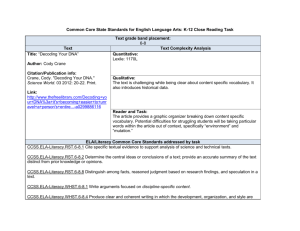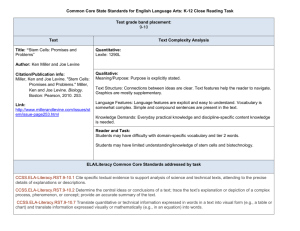Reading
advertisement
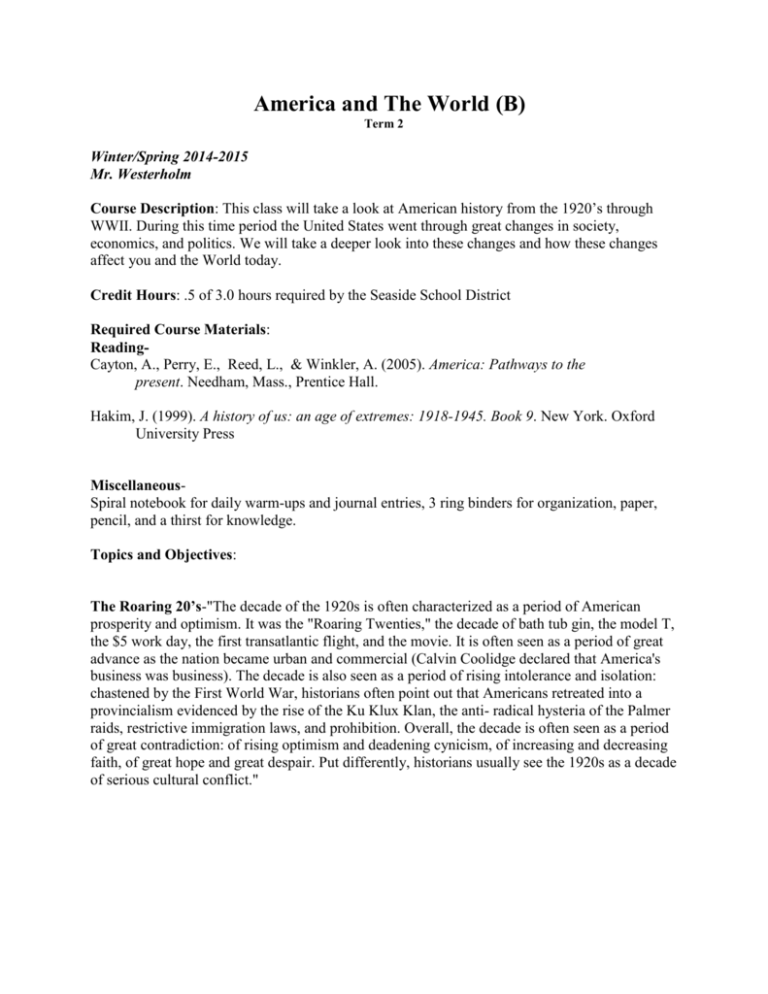
America and The World (B) Term 2 Winter/Spring 2014-2015 Mr. Westerholm Course Description: This class will take a look at American history from the 1920’s through WWII. During this time period the United States went through great changes in society, economics, and politics. We will take a deeper look into these changes and how these changes affect you and the World today. Credit Hours: .5 of 3.0 hours required by the Seaside School District Required Course Materials: ReadingCayton, A., Perry, E., Reed, L., & Winkler, A. (2005). America: Pathways to the present. Needham, Mass., Prentice Hall. Hakim, J. (1999). A history of us: an age of extremes: 1918-1945. Book 9. New York. Oxford University Press MiscellaneousSpiral notebook for daily warm-ups and journal entries, 3 ring binders for organization, paper, pencil, and a thirst for knowledge. Topics and Objectives: The Roaring 20’s-"The decade of the 1920s is often characterized as a period of American prosperity and optimism. It was the "Roaring Twenties," the decade of bath tub gin, the model T, the $5 work day, the first transatlantic flight, and the movie. It is often seen as a period of great advance as the nation became urban and commercial (Calvin Coolidge declared that America's business was business). The decade is also seen as a period of rising intolerance and isolation: chastened by the First World War, historians often point out that Americans retreated into a provincialism evidenced by the rise of the Ku Klux Klan, the anti- radical hysteria of the Palmer raids, restrictive immigration laws, and prohibition. Overall, the decade is often seen as a period of great contradiction: of rising optimism and deadening cynicism, of increasing and decreasing faith, of great hope and great despair. Put differently, historians usually see the 1920s as a decade of serious cultural conflict." Readings: Hakim- Ch. 4-15 Pathways to the Present- Ch. 13-14 Objectives: Ch. 13 1. Learn how women roles changed in the 1920s. 2. Find out how the nation’s cities and suburbs were affected by Americans on the move from rural areas. 3. Read about America’s heroes of the 1920s, and come to see the reasons for their popularity. 4. See how the mass media helped create common cultural experiences. 5. Realize why the decade of the 1920s was called the Jazz Age. 6. Discover how the writers of the Lost Generation responded to popular culture. 7. Find out about some of the subjects explored by the writers of the Harlem Renaissance. 8. Learn about the effects of Prohibition on Society. 9. Discover the issues of religion that were at the core of the Scopes trial. 10. Find out how racial tensions changed after WWI. Ch. 14 1. Learn about events that fueled the Red Scare of the early 1920s. 2. Find out about the conflicts that led to the major labor strikes of 1919. 3. See how the republican leadership during the Harding and Coolidge presidencies shaped the 1920s. 4. Discover the issues that shaped the presidential election of 1928. 5. Understand the role businesses and consumers play in a consumer economy. 6. Find out how Henry ford and the automobile were important to the 1920s. 7. Discover the ways in which industrial growth affected the economy of the 1920s. 8. See how the economic boom bypassed some people and benefited others. 9. See why the economy in the late 1920s appeared healthy to most Americans. 10. Observe the danger signs that were present in the economy of the late 1920s. The Great Depression-It isn't easy to give a brief summary of the Great Depression. It was, without a doubt, the longest and most severe economic downturn in American history. Widely held to begin with the stock market crash of 1929, the Depression lasted until the advent of American involvement in World War II. Will this current economic downturn have some of the same parallels as the 1930’s? Unemployment skyrocketed during the Depression years, reaching levels as high as one third of the population. Output shrank tremendously, falling by ten percent a year from 1929 to 1932. Nearly half of the commercial banks of the United States failed during the Depression. Crop prices fell by over fifty percent. People went hungry because so much food was produced that production became unprofitable. Others were unemployed because they had produced more than could be sold. Huge numbers of Americans had their lives upset by the Depression. Tens of thousands of migrant farm workers travelled the nation looking for employment. Homelessness, poverty and general despair characterized much of the nation. Readings: Hakim- Ch. 16-24 Pathways to the Present- Ch. 15-16 Objectives: Ch. 15 1. Learn about events that led to the stock markets Great Crash in 1929. 2. See how the Great Crash produced a ripple effect throughout the nation’s economy. 3. Become familiar with the main causes of the Great Depression. 4. Understand how poverty spread during the Great Depression. 5. Find out abut social problems that were caused by poverty in the 1930s. 6. Discover how some people struggled to survive hard times. 7. Read about ways Americans pulled together to survive the Great Depression. 8. See the signs of change Americans began to notice in the early 1930’s. 9. Find out how President Hoover responded to the Great Depression. 10. Learn what Roosevelt Meant when he offered Americans a “new Deal” 11. Realize Why the election of 1932 was a significant turning point in the American politics. CH. 16 1. Explore Franklin and Eleanor Roosevelt’s roles in restoring the nations hope. 2. Learn about the major New Deal programs that were create in the first hundred days, and find out about some of FDR’s key players in these programs. 3. Discover what caused the New deal to falter. 4. Review the key goals and accomplishments of the second new deal. 5. Interpret the significance of the outcome of the 1936 election. 6. Learn about some of the New Deals short comings and limitations. 7. Discover the chief complaints of FDR’s critics inside and outside of politics. 8. See how the court-packing fiasco harmed FDR’s reputation. 9. Learn about factors that led to the recession of 1937 and about the Roosevelt administrations response to the situation. 10. Find out about triumphs and setbacks experienced by the unions during the New Deal era. 11. Discover some effects of the New Deal on the American culture. 12. See what lasting effects can be attributed to the New Deal. WWII- This world war truly encompassed the world as a whole. As a class we will look into the underpinnings of this war and tie them to the failures of the Treaty of Versailles which ended the First Great War (The War to End all Wars). The United States tried to stay out of the war but the “Day that will live in Infamy” forced us to fight in the Pacific and get drawn into the European affair. Students will learn in detail the Pacific Theatre and European Theatre of war and how the American home front stood up and took on the challenge. This is the Generation that defines America during the War and who catapult us into the powerful nation of years to come. Hakim-ch. 25-44 Pathways to the Present-Ch. 17-18 Objectives: Ch. 17 1. Find out how the government and the economy of the Soviet Union changed under Stalin. 2. Discover the origins and the goals of Italy’s fascist government.. 3. See how Hitler rose to power in Germany and Europe in the 1930s. 4. Learn about the causes and results of the Spanish Civil War. 5. Understand how the German invasion of Poland led to war with Britain and France. 6. See what wartime victories and setbacks Germany experienced in Western Europe. 7. Find out why the Battle of Britain was an important victory for Britain. 8. Discover the causes and effects of Japans growing military power. 9. See why the Manchurian Incident was a turning point for Japans civil Government. 10. Find out about the initial outcome of the Japans war against China. 11. Learn why Japan looked beyond China for the future expansion. 12. Find out why the US chose neutrality in the 1930s. 13. See how American involvement in the European conflict grew from 1939-41. 14. Discover why Japans attack on Pearl Harbor led the US to declare war. Ch. 18 1. Find out how Roosevelt mobilized the armed forces. 2. Learn about ways in which the government prepared the economy for war. 3. See how the war affected daily life on the home front. 4. Find out about some ways in which Germany persecuted the Jews. 5. See how Germany’s policies toward the Jews developed murder and genocide. 6. Learn about advances Japan made in Asia and the Pacific in late 41 and 42. 7. Se which allied victories turned the tide of war in the Pacific. 8. Read about the strategy of the US in the struggle to re-conquer the Pacific Islands. 9. Discover why the battles of Iwo Jima and Okinawa were important. 10. Understand how the Manhattan Project brought the war to an end. Key Ideas and Details -- CCSS CCSS.ELA-Literacy.RH.9-10.1 Cite specific textual evidence to support analysis of primary and secondary sources, attending to such features as the date and origin of the information. CCSS.ELA-Literacy.RH.9-10.2 Determine the central ideas or information of a primary or secondary source; provide an accurate summary of how key events or ideas develop over the course of the text. CCSS.ELA-Literacy.RH.9-10.3 Analyze in detail a series of events described in a text; determine whether earlier events caused later ones or simply preceded them. Craft and Structure CCSS.ELA-Literacy.RH.9-10.4 Determine the meaning of words and phrases as they are used in a text, including vocabulary describing political, social, or economic aspects of history/social science. CCSS.ELA-Literacy.RH.9-10.5 Analyze how a text uses structure to emphasize key points or advance an explanation or analysis. CCSS.ELA-Literacy.RH.9-10.6 Compare the point of view of two or more authors for how they treat the same or similar topics, including which details they include and emphasize in their respective accounts. Integration of Knowledge and Ideas CCSS.ELA-Literacy.RH.9-10.7 Integrate quantitative or technical analysis (e.g., charts, research data) with qualitative analysis in print or digital text. CCSS.ELA-Literacy.RH.9-10.8 Assess the extent to which the reasoning and evidence in a text support the author’s claims. CCSS.ELA-Literacy.RH.9-10.9 Compare and contrast treatments of the same topic in several primary and secondary sources. Range of Reading and Level of Text Complexity CCSS.ELA-Literacy.RH.9-10.10 By the end of grade 10, read and comprehend history/social studies texts in the grades 9–10 text complexity band independently and proficiently Student Expectations: I expect students to come to class with the attitude that they will learn something each day. Open up your mind and let great things happen. 1. Respect the classroom 2. Respect your classmates 3. Respect the teacher 4. Respect yourself Grading: All material assigned should be turned in on due date. If material is late a 10% drop in grade will occur daily. If student has excused absence the assignment should be turned in no later than the number of days excused. 90-100 A 80-90 B 70-80 C 60-70 D 60-Under F
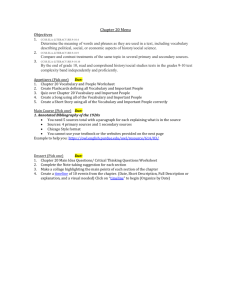
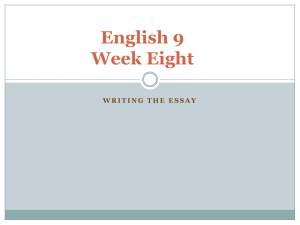



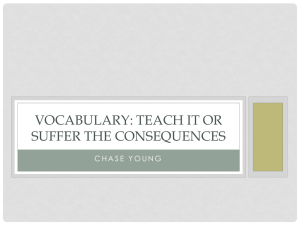
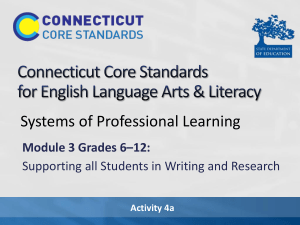
![iPads_and_Writing_2013[1]](http://s2.studylib.net/store/data/005383991_1-1bc8c0f2382c2ccb89e094c534f531f0-300x300.png)
